What can you learn from the design of giperkazualnyh games
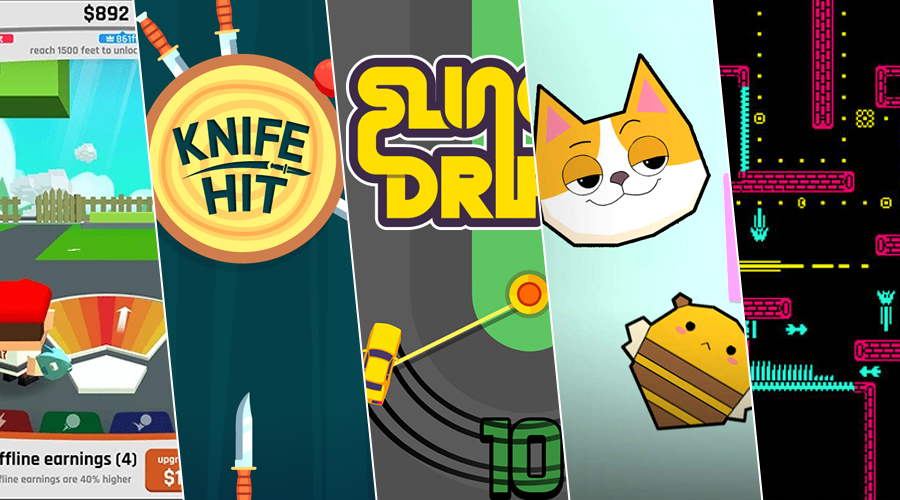
Someone may say that hypercasings are probably one of the simplest genres for analyzing game design. Someone may say that the hyperplay games are not even worth analyzing, because this trend will soon disappear, but I have a different opinion.
I can not say that they are a specialist in hyperpasual games. I am a simple consumer who no longer enjoys playing games as a consumer thanks to my professional education — I am an analytical game designer. Recently, I played a lot of hyper-casual games on a mobile platform (and analyzed them), so I decided to briefly write about their attractiveness and what game designers can learn from them. Again, this is not a ready-made guide to creating hyper-casings, but a brief overview of various game design solutions and systems that help hyper-casual games to be fun.
Hyper ... what?
If one of you has been living in a cave for the last few years, I’ll inform you that a hyper-casual game is a super-simple game that creates an addictive gameplay cycle, complemented by minimalistic graphics, and usually doesn’t require anything other than touching the screen. Often these games have straightforward goals - to score the most points ( Stack ), complete the levels ( Phases ), and the like. They seem to have been developed for game jam, but have a higher production quality and meta.
If you are like me and are weekly exploring the newest App Store, then you will notice that hyperplaying games flooded the App Store, and for good reason. These games are based on minimalism, which means that developers can create them quickly, within a matter of months, if not weeks. This is part of the strategy that has brought success to the hyperlinking, and you can see that all the major publishers of hyperplay games like Ketchapp, Voodoo, Appsolute Games release at least one game per week. And people like them - in 2018, the hyperplayed games were downloaded over 100 million times!
')
But enough about numbers and analytics, for now get down to business!
Give already play!
For the sake of simplicity and because of the inability to play all the hyper-casual games for mobile platforms, while studying various branches of the genre, I will use as examples some of the most popular projects.
So let's get down to learning .
Once I was bored and I climbed on Instagram. So I came across a game called Ball Blast . A short 30-second video showing only its best features made me download the game. The video showed how easy it is to play a game and win it. She looked fascinating. I wanted to start playing it right away, and this was made possible thanks to the very small size of the file being downloaded — a critical feature of the hyper-reading box .
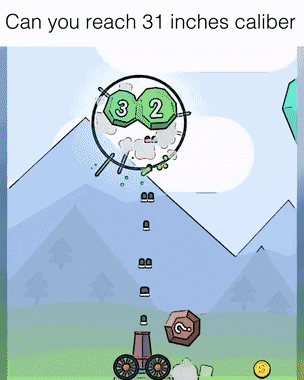
An example of advertising shown in social networks
Now you understand how most users find these games. Mostly hypercouples rely on social media User Acquisition campaigns. If a person scrolls through one of these social media channels, it can be assumed that he is bored. He is looking for a way to get rid of boredom, and here, like a knight in white armor , there are hypercasters, hurrying to save the user.
The principle is to quickly inform potential players that the game is extremely exciting and allow them to instantly start playing it. They hang on the Internet from the phone, which means there is a possibility that the mobile tariff is used. No one likes to download gigabytes of data on a mobile tariff. Even if you are connected to Wi-Fi with a good download speed, it is difficult to endure, having learned from the advertisement about how exciting the game looks. Hence the small amount of downloaded files .
So, the player managed to download the game and he is ready to enter the game world. What's next? We turn to the next topic - the entrance to the game .
The player takes about 7 seconds to understand if the game is interesting and whether it is worth the space spent on the phone. Such a short window means that there should not be any long tutorials or UI transitions ! That's exactly what's done in Ball Blast . At the time of launch, you see the game screen, which says " swipe to shoot ", and this is the only "tutorial" on the gameplay that you will see. The player touches the screen and the gun starts shooting.

How friendly!
When you start to shoot, you will notice that the gun can also move horizontally, following the finger. When the brain gets used to the idea of shooting and movement, a lot of numbered balls will appear in the game area that need to be shot. You shoot at the balls, see how they explode, scattering coins, and understand that large balls are broken into small ones. It's simple, isn't it?
The same goes for Ketchapp’s cute tiny game called Stack : when launched, it shows the game screen, allowing the player to start the game by touching anywhere on the screen. As soon as he touches the screen, he will see squares moving from different sides and realize that when the screen is touched, the moving square falls on a stack of squares under it, and all its parts outside the stack are cut off. Since these games can boast the only simple mechanics, they are fairly easy to learn how to play without complicated tutorials. The player learns by failing and coping with difficulties. The gameplay is " suitable for Youtube ", that is, it is easy to learn, just by watching .

Enter and exit!
Have you noticed how fast and easy it is to start playing a hyper-casual game on your phone? Take the phone, unlock it, touch the game icon and after 2 seconds you are already in the game! Is not that great?
This is what the brain needs when it is deadly bored and requires a magic potion to instantly stimulate interest. I start the game, play one session, lose a couple of times, set my new record and get my rewards. This is the basis of the short feedback loop of the basic gameplay. Actions that affect success or failure, the player reads instantly. We combine this with upgrades ( about them below ), and we get a powerful loop of positive feedback, giving a reward, very exciting and at the same time short.

Feedback loop circuit. The player is improved by failure.
If you managed to create a game with an exciting gameplay "hook" and the players love it, then keep in mind - perhaps this is the only thing that matters to them in your game. Ball Blast plunges into the thick of the action immediately after starting the game, because it understands my need - instant entertainment. No wandering around UI, cutscene or text.
Even if I start the game a week later, thanks to the super-simple mechanics and the lack of previous development, I will know how to interact with it. Logging in and out of a gaming session is another crucial aspect contributing to the success of such games.
At work, I often take breaks in the form of short gaming sessions on the phone, and for the same reason, I use hyper-poker for this. I know that I have neither time nor space for something “ complicated ”. Hyper-casual games give me my dose of entertainment where and when I want it .
Give me all the power!
Here, everything becomes more interesting. As mentioned above, players are attracted to the game baseline gameplay. It is simple, but it is addictive and the increase in skill in it encourages players to return. You may recall Ball Blast and ask yourself - what is fascinating about the constant shooting of balls? I was also interested in this when I first saw the advertisement of the game - “Well, yes, it looks fun, but will it be as fun in a couple of days?”. I will answer this question - yes, I was still interested, and interesting even now!
To better understand what is the basis of fascination, you need to talk about its key reason - upgrades !
Ball Blast rewards you for destroying the balls with coins and jewels - the local currency of the game. Let's talk about coins, because jewels allow you to buy only decorations and do not really affect the gameplay. Coins are used to upgrade guns. There are four types of upgrades:
- Fire Speed : increases shooting speed.
- Fire Power : Increase damage done by shells.
- Coins Drop : Increases the denomination and frequency of coins dropped after shooting balls.
- Offline Earnings : increases the number of coins received when the game runs in the background.
If you look closely at the upgrades, you can see that all of them together are needed to increase the player’s “ strength ” in the game. For example, pumping upgrades Coins Drop allows you to collect more coins per session, which makes it easier to accumulate coins and buy other upgrades. Upgrades guns make the player feel stronger, because they allow you to quickly destroy the balls, even large ones, which at a certain stage is more difficult to destroy. And therein lies the peculiarity of the basic cycle of the game. After each session, the player feels that he has become stronger . The player always craves the power that can be achieved only by playing more, earning coins, and then spending them on upgrading his strength.
The levels are carefully balanced so as to underpin this cycle: they give the player areas to demonstrate his power, and then bring into play more durable balls that motivate you to upgrade the cannon even more. The development process is not only significant, but also easily understood. Give the game only five minutes, and you will understand what I'm talking about.
Another game in which this technique is applied quite well is Mr. Gun company Ketchapp . The player kills enemies, coins fall out of them, which can then be spent on increasing damage and frequency of shooting, increasing his “strength” in the game. The player gets his first powerful gun pretty quickly, as a gift, and so the game teaches him upgrades: they are presented in the form of weapons, which gives an advantage in the sessions.
I would like to take this opportunity and compare this type of hyperplay games with the dungeon crawler genre.
If you played Diablo or any other dungeon crawler, then you know that at first you have mediocre equipment and you fight against enemies of the first level , which are quite simple, but still require several blows. Continuing your adventure, you get powerful equipment that allows you to kill these first-level enemies with one stroke. Suddenly you start to feel very powerful, now nothing will stop you ...
... Until you reach a new level and the game does not throw at you enemies of the second level , and soon you realize that your powerful equipment is no longer so powerful. Feeling the maximum power once, you want to bring it back. You again crave to feel power, and the cycle continues.
Ball Blast in a similar way allows you to feel the power, but instead of more powerful equipment, it allows you to improve / upgrade the gun, and the levels with a carefully thought-out pace make you crave for greater power.
And if there are no upgrades?
You can ask - " upgrades - this, of course, is good, but what about the games in which they are not there? ". “Good question,” I will answer! You know the games, the goal of which is to achieve the maximum score among all players or among friends. These games use a special kind of power . Let's take for example Stack , where the player’s task is to achieve the best score by repeating sessions many times. Of course, he cannot “ upgrade ” anything, but the more he plays, the better he masters the game. Instead of pumping the game element, the player upgrades his own skills. This motivates him to continue to do this. And if you also compel him to compete with friends, as most games do with the help of a leaderboard, then the matter is already becoming personal and competitive - another lure that forces you to return to the game. "I would never let Mark get around me in this game!"
Such implicit upgrades make the player feel smart or strong, and give a sense of development. The same applies to hyper-casual games based on puzzles, where the player feels smarter, solving more and more puzzles, the complexity of which is gradually increasing.
Today often there are hyper-casks divided into levels. Instead of endless gameplay, they break the gameplay into specially designed levels, and each level has something unique with increasing complexity. This breeds curiosity, encouraging players to continue playing and “winning” the game. In addition, the transition from level to level is a great way to inspire the player with a sense of development.
Secret ingredient
So far we have been talking only about the fact that hyperplaying games attract players with aggressive advertising in social networks, keeping them fast diving into the game and enticing simple mechanics in which he craves more power, but is that all?
No
The magic element invisible to the naked eye and, in my opinion, the most important aspect of the game is gratification .
What is " satisfaction "? Here is the definition from the dictionary:
pleasure, in particular, obtained through the fulfillment of desire.
In order to better understand it from the point of view of game design, satisfaction can be defined as the kind of visual / sound / emotional feedback obtained after performing an active or passive action in a game, making actions both joyful and meaningful. The action can be simple: walk, jump or shoot.
Here are some examples:
Did you notice how rosy and responsive the character's movements are in Super Meat Boy ? As soon as you press the jump button, the character jumps up and down gracefully in an arc, taking into account the impulse, and all this is complemented by animation with perfectly matched timing. From making the perfect jump to cross the abyss or obstacle, the player gets a return. Since the game requires fast and accurate movements from the player, the entire gaming system is designed to give the user satisfaction in the form of effects, obstacles and problem solving.
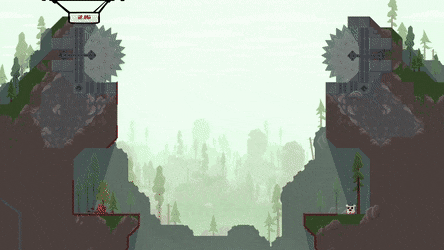
Housemarque's Nex Machina ( master of satisfaction ) - when a bullet hits the enemy, the player receives confirmation of a successful hit in the form of a small white flash on the enemy, after the death of which there is a big explosion from the cubes, accompanied by appropriate sound effects. This gives the player a feeling of satisfaction and euphoria in the killing of just one enemy. Imagine killing the boss now! Different types of weapons, enemies and levels at each stage bring satisfaction to the user. I recommend to play this game.
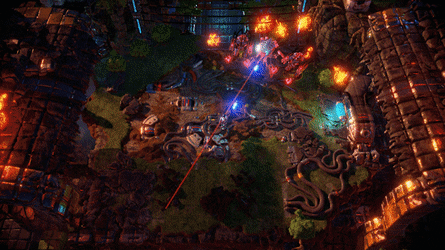
You probably already understood that gratification is such an extensive topic that it requires a separate post. Here I told about him in order to emphasize how well hyper-casual games understand the principle of satisfaction and use it to provide an exciting gameplay.
Recall Ball Blast . Super-responsive control of the gun, which exactly follows the finger movement, feedback in the form of notation of hits on the balls and how they break up into smaller balls, the effect of temporary bonuses on the game and, of course, " upgrades " - all these elements work together and provide fascinating feedback throughout the game.
Take any good game, analyze the factors that provide satisfaction from the actions and make them bring joy. You will see how these small details, often remaining invisible, increase the satisfaction and involvement in the game. Hypercouches in this sense are no different, and when creating such systems experienced designers take into account satisfaction . Another great example is Stack Fall (by Voodoo). The player controls a bouncing ball that falls when it touches the screen for a long time, smashing a stack of blocks along the way. Paint splashes, tactile feedback, block destruction are some of the elements that increase satisfaction and improve the gameplay.
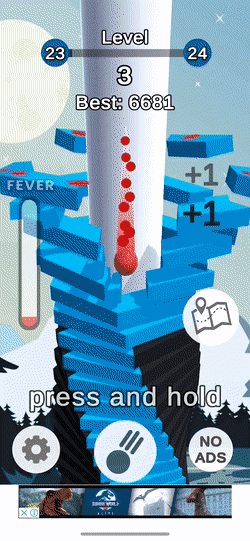
Whatever the action, the player must be satisfied with it. Imagine a platformer in which the character jumps, but when he lands, there is no animation reporting a change in state, or dust effects in the place where he landed. Imagine how strange and boring it would feel. And this principle is not limited to the game actions: you can give the player satisfaction through the UI, using appropriate and subtle effects and animations. As an example, I can cite Homescapes . After passing the level begins to play a lot of effects and animations, emphasizing the victory of the player and reward him for this achievement. Even more reward, if the level is difficult, and you finally managed to pass it: the satisfaction received from the " Level Cleared " screen makes it clear that it was worth it. Not only the UI, but also every action performed by a player on a level brings great satisfaction and is pleasing to the eye.

That's what I call GIF in HD quality!
The fascinating basic cycle, combined with the elements that increase satisfaction, are the main ingredients needed to create an interesting hyperplaying game.
Conclusion
Once I was afraid of hyperlinks, and there were my own reasons for this: lack of graphics, almost no originality, aggressive promotion, and much more. I believed that innovative games fall into the shadow of this horde of hyperkazualok, weekly appearing in the App Store.
I am one of those who consider games to be an art form, carefully thought out and elaborated works, and that is why it takes several years to release them. For all these reasons, at first glance, the hyper-casual games made not the best impression on me.
We, as designers, are proud to create complex gaming systems with multi-layer depth, but often neglect the simplest elements. Hypercovers have forced me to pay attention to smaller details. They allowed me to take a fresh look at the design of games, the fundamental essence of the game, which determines its fascination.
- Mechanics in which it is difficult to get confused, and not requiring any tutorials.
- Satisfaction to stimulate player action and create fun.
- Short feedback loops.
- Ease of entry and exit from the game.
- A sense of strength / rationality in the form of development.
- Simple meta, supporting basic gameplay.
Who knows what the future awaits hyper-casters. I don’t know if they will continue, but this genre has much to learn and lessons learned can help in creating the design of your game in any genre.
I understand that this genre and business model have problems, but we will leave their analysis for later.
What do you think about hyperlinks? Do you think that they allow a new look at the design of games? Have you learned anything from this genre?
Source: https://habr.com/ru/post/458918/
All Articles